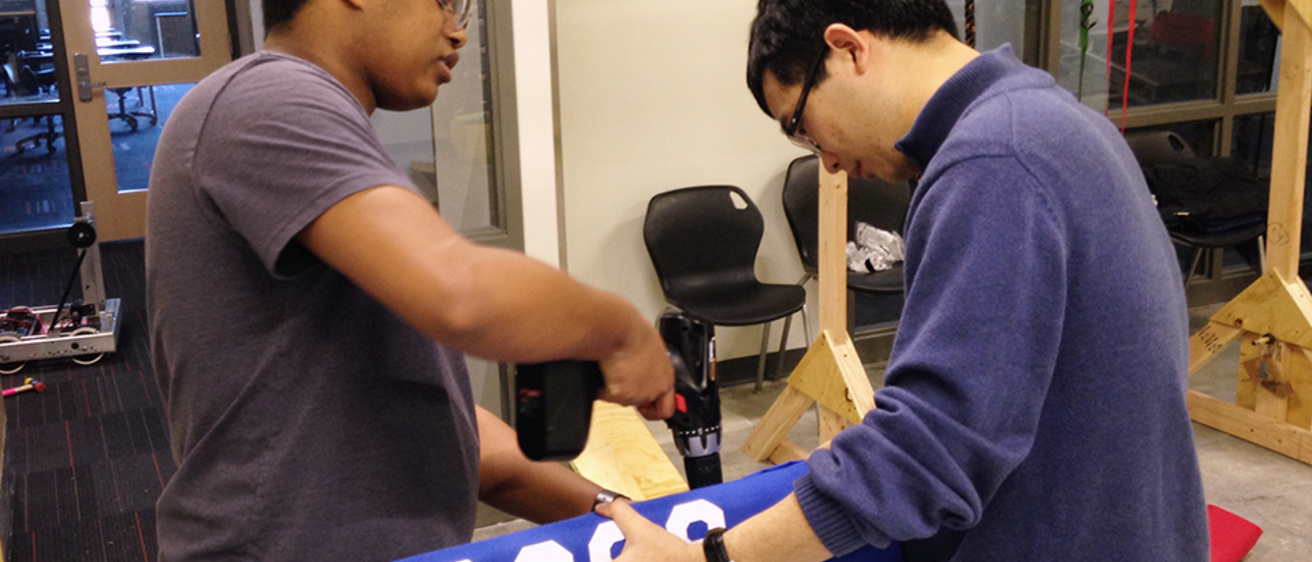Iowa City West High School student Danny Grimes is using an electric drill to work on a bumper for a robot. Each time he lowers the drill to the bumper’s hard back, he uses his fingers to feel for the bit and place it where it needs to go.
“Careful now, careful,” says Xuan Song, assistant professor of mechanical and industrial engineering at the University of Iowa’s College of Engineering. “You’ve almost got it. Oh, wait, the bit’s not straight. Move your hand.”
Danny, who is blind, follows Song’s instructions and maneuvers the drill into the right position. “That’s how life goes,” he says. “You try and you fail, and then you try and you fail again, but eventually you get it right.”
Danny is part of a team of students from the Iowa Educational Services for the Blind and Visually Impaired (IESBVI) that will compete in the FIRST Robotics Competition March 23–25 in Cedar Falls. It’s the first time Iowa’s Braille and Sight Saving School has entered the contest, and a small group of UI professors and graduate students is supporting its inaugural effort.
“We help them design mechanical parts, wire circuit boards, and program the mobile robot for desired tasks,” says Zhen Kan, assistant professor of mechanical and industrial engineering, who has been spending Saturdays working with students in the basement of the Kirkwood Regional Center at the UI’s Oakdale Campus in Coralville.
“I see this as a great opportunity to inspire the students’ interests in robotic systems,” Kan says. “It’s been great to see them working together.”
The robotics team—called the Dark Side—is made up of six students from across the state who are blind or visually impaired. Besides Grimes, they are James Cheek of Nevada, Joel Murray of Council Bluffs, Gabe Urbano of Hampton, Kadyn Haggard of Humboldt, and Cody Davis of Estherville. The team also includes two sighted members, Gabe Trappe and Eric Rush, both students at Iowa City West High School.
IESBVI math consultant Sara Larkin came up with the idea to enter the robotics competition. She received funding through the Iowa STEM Scale-Up Program and assembled her team. Then she hit a roadblock: She needed engineers to coach the students. When inquiries to local engineering firms went unanswered, she started to worry. A colleague, Jennifer Bliss, STEM consultant for IESBVI, knew someone who could help.
Bliss’ husband is Eric Hoffman, director of the Advanced Pulmonary Physiomic Imaging Lab (APPIL) in the UI Department of Radiology. She asked Hoffman if he could recruit some engineers, and he delivered.
Hoffman pulled in graduate students and a postdoctoral research fellow from his research group and used connections across campus at the College of Engineering to mobilize additional professors and graduate students from the Department of Mechanical and Industrial Engineering. In no time, the blind school team had some of the brightest minds on the UI campus working with them.
“We couldn’t have done it without them,” says Larkin. “They are so patient with the students; they work really well together.”
On a recent Saturday, the students and academics met to put the final touches on their robot, which they built from a basic kit of parts and augmented with wood, metal, and plastic. The robot has foam bumpers and is equipped with Wi-Fi; it stands about 24 inches tall and is about 40 inches wide.
During the competition, students will use their robot to prepare a mock spaceship for take-off. For this to happen, they need to use computer coding to program the robot to perform certain tasks, including remote-controlled maneuvering, acquiring and delivering gears, and climbing a rope.
One of those working on the coding was James Cheek, who uses a laptop equipped with software that reads aloud the text he types into the computer. As James works, the computer talks to him in a digitalized voice.
“The more tasks our robot performs, the more points we score,” James says. “We’d like our robot to be autonomous for at least 15 seconds.”
Nearby, James’ friend Kadyn Haggard is working on some electrical wiring. Larkin asks Kadyn to explain what he is doing. When the teenager has trouble doing so, she reminds Kadyn that competition judges could ask similar questions.
“The judges will ask you about the gauges, so you should know how much voltage goes through the wires,” she says.
For engineering professor Song, working with the blind students has taught him a lot about being a good classroom instructor.
“I realize the importance of doing and showing in the classroom,” says Song. “If students don’t have the opportunity to actually build a robot, for example, they may never believe they can do this. After they complete the project, they have more confidence in themselves and their skills.”
Professors and graduate students say there have been many times during the project when they have been impressed by the teenagers’ skills. There also have been moments of shared joy and wonder.
“Once, I saw a student dropping a piece of metal and listening carefully to the sound it made when it hit the ground,” says Song. “He asked me what this beautiful sound was and when I told him it was aluminum, he said, ‘I love aluminum!’ He was so excited.”
Other UI community members involved in the project are Amin Motahari, a postdoctoral research fellow with an electrical engineering background who works at APPIL; Jacob Hermann, a graduate student in biomedical engineering at APPIL; Bakir Hajdarevic, a graduate student in biomedical engineering at APPIL; and Baike She, a mechanical engineering graduate student in the College of Engineering.
For more information about the 2017 First Robotics Competition, visit www.youtube.com/watch?v=EMiNmJW7enI.
